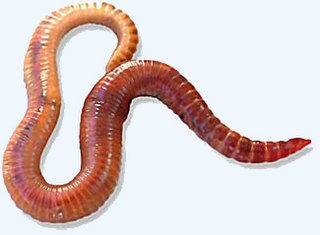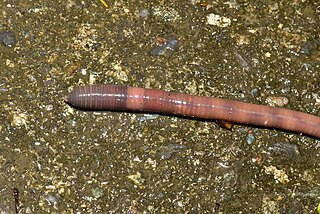
Vermicompost (vermi-compost) is the product of the decomposition process using various species of worms, usually red wigglers, white worms, and other earthworms, to create a mixture of decomposing vegetable or food waste, bedding materials, and vermicast. This process is called vermicomposting, with the rearing of worms for this purpose is called vermiculture.

Lumbricus terrestris is a large, reddish worm species thought to be native to Western Europe, now widely distributed around the world. In some areas where it is an introduced species, some people consider it to be a significant pest for out-competing native worms.

The Lumbricidae are a family of earthworms. About 33 lumbricid species have become naturalized around the world, but the bulk of the species are in the Holarctic region: from Canada and the United States and throughout Eurasia to Japan. An enigmatic species in Tasmania is Eophila eti. Currently, 670 valid species and subspecies in about 42 genera are recognized. This family includes the majority of earthworm species well known in Europe and Asia.

Oligochaeta is a subclass of soft-bodied animals in the phylum Annelida, which is made up of many types of aquatic and terrestrial worms, including all of the various earthworms. Specifically, oligochaetes comprise the terrestrial megadrile earthworms, and freshwater or semiterrestrial microdrile forms, including the tubificids, pot worms and ice worms (Enchytraeidae), blackworms (Lumbriculidae) and several interstitial marine worms.

Megascolecidae is a family of earthworms native to Madagascar, Australia, New Zealand, Asia, and North America. All species of the Megascolecidae belong to the Clitellata class. The Megascolecidae comprise a large family of earthworms and they can grow up to 2 meters in length. The intercontinental distribution of Megascolecidae species favours the continental drift theory.

Eisenia fetida, known under various common names such as manure worm, redworm, brandling worm, panfish worm, trout worm, tiger worm, red wiggler worm, etc., is a species of earthworm adapted to decaying organic material. These worms thrive in rotting vegetation, compost, and manure. They are epigean, rarely found in soil. In this trait, they resemble Lumbricus rubellus.

The Clitellata are a class of annelid worms, characterized by having a clitellum – the 'collar' that forms a reproductive cocoon during part of their life cycles. The clitellates comprise around 8,000 species. Unlike the class of Polychaeta, they do not have parapodia and their heads are less developed.
The Eudrilidae are a family of earthworms, mostly of Africa. One species, Eudrilus eugeniae, is widely distributed around the warmer parts of the world and historically cultured as the "African nightcrawler".
Eisenia andrei is a close relative of the 'brandling' or 'tiger' worm Eisenia fetida. Like E. fetida, it is epigeic, i.e. it prefers to live in compost or leaf litter rather than mineral soils.

Leeches are segmented parasitic or predatory worms that comprise the subclass Hirudinea within the phylum Annelida. They are closely related to the oligochaetes, which include the earthworm, and like them have soft, muscular segmented bodies that can lengthen and contract. Both groups are hermaphrodites and have a clitellum, but leeches typically differ from the oligochaetes in having suckers at both ends and in having ring markings that do not correspond with their internal segmentation. The body is muscular and relatively solid, and the coelom, the spacious body cavity found in other annelids, is reduced to small channels.

An earthworm is a soil-dwelling terrestrial invertebrate that belongs to the phylum Annelida. The term is the common name for the largest members of the class Oligochaeta. In classical systems, they were in the order of Opisthopora since the male pores opened posterior to the female pores, although the internal male segments are anterior to the female. Theoretical cladistic studies have placed them in the suborder Lumbricina of the order Haplotaxida, but this may change. Other slang names for earthworms include "dew-worm", "rainworm", "nightcrawler", and "angleworm". Larger terrestrial earthworms are also called megadriles as opposed to the microdriles in the semiaquatic families Tubificidae, Lumbricidae and Enchytraeidae. The megadriles are characterized by a distinct clitellum and a vascular system with true capillaries.

The European nightcrawler is a medium-small earthworm averaging about 1.5 g when fully grown. Generally blueish, pink-grey in color with a banded or striped appearance, the tips of their tails are often cream or pale yellow. When the species has not been feeding, it is pale pink. The species is usually found in deep woodland litter and garden soils that are rich in organic matter in European countries. D. hortensis is sold primarily as a bait worm, but its popularity as a composting worm is increasing.

Invasive species of earthworms from the suborder Lumbricina have been expanding their range in North America. Earthworms are considered one of the most abundant macroinvertebrates in the soil of ecosystems in temperate and tropical climates. There are around 3,000 species known worldwide. They are considered keystone species in their native habitats of Asia and Europe because, as detritivores, they alter many different variables of their ecosystem. Their introduction to North America has had marked effects on the nutrient cycles and soil profiles in temperate forests. These earthworms increase the cycling and leaching of nutrients by breaking up decaying organic matter and spreading it into the soil. This thins out the soil rapidly because earthworms do not require a mate to reproduce, allowing them to spread fast. Since plants native to these northern forests are evolutionarily adapted to the presence of thick layers of decaying organic matter, the introduction of worms can lead to a loss of biodiversity as young plants face less nutrient-rich conditions. Some species of trees and other plants may be incapable of surviving such changes in available nutrients. This change in the plant diversity in turn affects other organisms and often leads to increased invasions of other exotic species as well as overall forest decline. They are considered one of the most invasive animals in the Midwestern United States along with feral swine.
Microchaetus rappi, the African giant earthworm, is a large earthworm in the family Microchaetidae, the largest of the segmented worms. It averages about 1.4 meters in length, but can reach a length of as much as 6.7 meters and can weigh over 1.5 kilograms.

Amynthas is a genus of earthworms in the family Megascolecidae. They are known as jumping worms, snake worms, or crazy worms because of their erratic thrashing behaviour when disturbed. The genus is native to East Asia, but they are invasive in many areas of the United States. They are a matter of concern in many states, as they disrupt the native forest ecology by affecting soil structure and chemistry.
Earthworms are invasive species throughout the world. Of a total of about 6,000 species of earthworm, about 120 species are widely distributed around the globe. These are the peregrine or cosmopolitan earthworms. Some of these are invasive species in many regions.

The annelids, also known as the segmented worms, are a large phylum, with over 22,000 extant species including ragworms, earthworms, and leeches. The species exist in and have adapted to various ecologies – some in marine environments as distinct as tidal zones and hydrothermal vents, others in fresh water, and yet others in moist terrestrial environments.
Octochaetus multiporus, commonly known as the New Zealand earthworm, is a megascolecid worm endemic to New Zealand. It is mainly found in the south of Manawatu but may also be found along the east coast of the South Island. A bioluminescent worm, Octochaetus multiporus secretes a luminescent fluid from its mouth when disturbed or punctured.

Maldanidae is a family of more than 200 species of marine polychaetes commonly known as bamboo worms or maldanid worms. They belong to the order Capitellida, in the phylum Annelida. They are most closely related to family Arenicolidae, and together form the clade Maldanomorpha.












